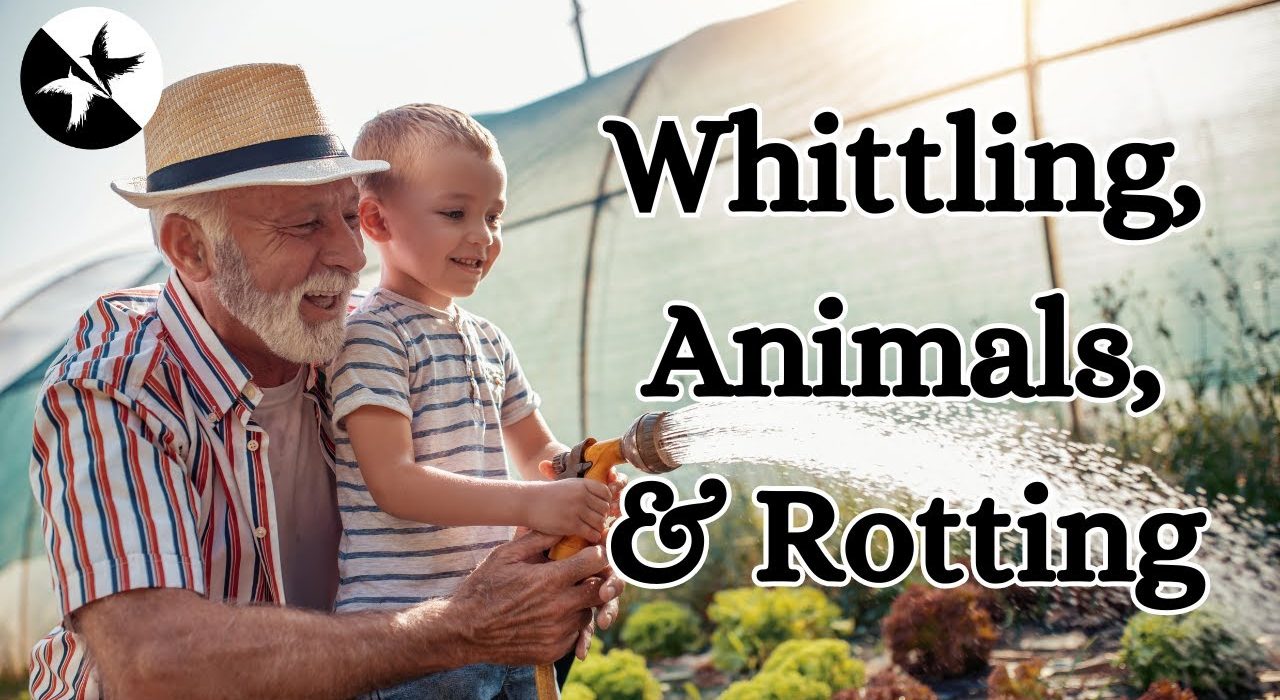Where did your characters learn their skill sets? Do you want to learn natural ways for your characters to interact with your other characters? Do you need inspiration to show the tight bonds of a family? What do axes and seeds have to do with this? Find out on this episode.
Welcome to Writing Rural with Alley, the fiction writer’s weekly inspiration station for rural life and lifestyles, from historical to post-apocalyptic, helping you bring your rural stories to life! I’m Alley, and this is episode #71, 10 Generationally Passed Skills (Part 1). Stick around to the end to find out all the ways things could possibly go wrong. Now, let’s get into this.
Rural life has many skills that are passed down from one generation to the next. Some are passed down to everyone, and others are passed down to individuals who want to learn them. Parents, grandparents, aunts, uncles, and even older siblings can teach these skills. Today we will cover 10 of them.
1) Gardening
Ok, maybe you saw this one coming. Historically, gardening was the way many people saved food for winter, making this a vital part of life. Today, most people in rural areas still garden, but fewer and fewer rely solely on gardening as their main food source.
The first thing people passed down was when to plant. Growing up, St. Patrick’s day was the day we planted potatoes, May 7th was the last potential frost day, and corn was always planted when the oak tree’s leaves were the size of a squirrel’s ear. Yes, I have Native American heritage.
Things that were taught include, but are not limited to, how to prep the garden, how to plant, how to spot the weeds that sneak in among the new sprouts, how to tend the garden, looking for disease and how to cure them when they are found, what to add to the soil to best give each plant the nutrients it needs, how to make a trellis and what plants to go with it, what plants could be planted together, what plants could not be planted together, when to harvest, how to harvest, how to preserve the food, and the very important how much food do they need for not only the entire winter but through the spring until the first spring foods become ripe.
In modern times, farmers do these things on an industrial scale to sell to market. That comes with many skills also. The timing of the planting, harvest, using and maintaining any machinery, upkeep of buildings and storage such as silos and sheds for the tractor and other equipment.
If you would like to learn more about gardening, I have a full episode about it. I also have several on food preservation methods.
2) Whittling
Next on the list is whittling. Whittling, in this case, is taking a pocket knife and carving a stick, gourd, or other natural material to make a specific shape. This is most often a toy, but can be figurines. My great-grandfather even whittled a bride and groom made of soap for my grandmother’s wedding.
Yes, it is true this skill can be learned through trial and error, but it is very often taught from grandparents, or other skilled family member to kids. Yes, kids. All my children had their own pocket knives by age seven, but Amish children get them far younger than mine did.
Many of the things people enjoy making are trains, balls, balls inside of a cage, toy animals, toy soldiers, toy people, toy wagons, and so much more. Most people have certain ways they enjoy carving things, and they have their own specialties. Some people feather the wood, and others carve out pieces.
For larger creations, the person might even get out a chisel to work on the details that a knife would have a hard time carving out.
The earliest known wooden toy dates back to ancient Egypt, where they have found wooden dolls, animals and small chariots.
3) Sewing
Sewing is important for many things. Everything from clothing to curtains to furniture can be sewn and mended. This is often taught to young girls. They love sewing clothing for their dolls. At least I did, and I didn’t even like dolls that much. But don’t be fooled, boys learn this skill too. They just don’t normally use it as much.
There are two types of sewing. Hand sewing and machine sewing. The first sewing machine (that I can find) was actually a leather sewing machine, that was invented by Tomas Saint’s in 1790. In 1814 and 1816, proto types of the sewing machine were invented. However, the first widely used sewing machine was patented in France in the year 1830 by the French tailor, Barthelemy Thimonnier. This was the first lock stich sewing machine. Lock stich is a fancy way of saying there are two lines of thread, one on each side of the cloth, and they are sewn in a way that interlaces the two threads to hold the cloth together. These were, of course, all foot pedal powered. Your foot moved a petal that was attached to a belt that caused the machine to move.
Nowadays, we have electric sewing machines. While we still have a peddle, it is pressed down, much like the gas pedal of a car. How hard you press determines how fast the machine goes. Be careful with this one. I have known a lot of people who were going so fast they sewed their finger right along with the cloth. I hear that hurts. That said, I know preteens that are better than me with a sewing machine. The child’s ability to be careful will determine if they are ready to learn this.
Hand sewing, on the other hand, can be learned much younger. I let my daughter use a large (and less pokey) embroidery needle and thread to practice how to make stitches in a straight line, when she was only three. Surprisingly, she was very careful, and did an excellent job. I would never have let some of the other kids touch them that young, because they would have not been careful. Most children in history learned early. In fact, choking to death on buttons was very sadly common for children under three, and sometimes older.
Hand stitching takes practice and time to learn. There will be mess ups, and they will at some point have to take a seam ripper to remove them. A seam ripper is a small metal thread cutter that can be placed between the cloth and thread to cut the thread and not the cloth.
People who have done this for a long time or are very skilled can make a shirt or pants in a few hours. The rest of us might take all day, or a few days.
4) Animal husbandry/raise livestock
Live stock are an essential part of rural life. Learning to care for them properly is not something learned overnight. There are feed needs all year round. Most people let their animals eat the grass in the summer. However, this isn’t always an option in the winter. Historical stories and post-apocalyptic stories will need to save feed during the summer months for winter. In more modern stories, feed can be bought at the local feed mill. Think of it like PetSmart, but for livestock, and buying in bulk.
The feed store also carry fencing, cages, things to make cages, medicine and other things of this nature. Your characters will need to take care of sick animals, and set up their own fences. Keep in mind the fences can and also are designed to keep them out of things that could hurt them. You don’t want cows falling down the well, and your characters will want to keep the garden safe from the livestock.
5) Washing laundry by hand
This is one that is passed down to everyone. Historically, it did tend to fall to the women, but men also learned how. In fact, my father is the one who taught me how to do it. However, some cultures have the men taking the main laundry role. In ancient Rome, they believed laundry was too physical for women and the men did it.
I have a whole episode on washing laundry by hand if you want to learn more about the process.
6) Trapping
Trapping has been a big part of life for almost every people group in the whole world until the industrial revolution, but many people still do it today. In fact, many people around the world still do this as a way of life.
Trapping is usually done to catch small game, but can be used for larger game. Trapping helps to provide needed meat for the winter. It also is a source of leather. Leather can be used to make clothing, gloves, shoes, tepees, saddles, pouches, belts, and so much more.
7) Candle making
Candles are a great alternative light source. This can be used at night and in the winter when the days are shorter. They can be made with many different ingredients. What ingredients they use is likely dependent on the era and region they live. Modern candles are made with paraffin wax. While many historical candles were made with beeswax. However, they have also been made of whales blubber. The wicks today are commonly cotton. Historically, they have been made of wood, cattail fluff, and more.
8) Well drilling or well digging
Wells have been and are still an important part of obtaining clean safe water. Most small towns that are not near a river or other large body of water also use wells. In modern times, these are drilled with a special drilling machine, but before wells were drilled, they were hand dug. This is a learned skill.
Where to dig, how deep, where not to have a well, and maybe most importantly, how to stay safe while digging a well were all important skills. Now I hear you, “But Alley, what could be dangerous about digging a hole?” A few things. There was the chance the well would collapse on the person digging it if it was not properly reinforced. There were sometimes gases found underground that killed people. These could include carbon dioxide, methane, hydrogen sulfate, and other volatile organic compounds.
Many times people worked together to dig a well, and it could take days, weeks or months depending on how deep it was, how many people were helping and many other factors. The farther down a well was dug, the higher up the dirt and rocks had to be hauled up. This led to the dangerous, and sometimes deadly, chance of the rope breaking and the dirt and rocks falling back onto the person in the well. Painful at a few feet, but large rocks falling on a person at even ten feet could be deadly.
I have two episodes on wells if you would like to learn more about the different types of wells.
9) Wood chopping
Wood chopping is also called splitting wood or even chopping firewood. This is the act of taking tree trunks, or even large branches, and splitting them into several pieces with an ax. This is a skill to learn, because if your character does it wrong, they will be expelling more energy than they need to. They will also need to learn the safest way to chop the wood. They don’t want to risk swinging the ax into their foot, or leg.
There is also a physical aspect to this one. It is much like an exercising, engaging almost the full body. Your characters will only be able to do this for a time until they build up to being able to do this for longer periods of time. After years, they will be able to do this quickly and make it look easy. That still isn’t me.
10) Saving seeds
Saving seeds is the last on today’s list. Saving the seeds from a garden to plant in the next years’ garden is important. If there are no seeds, any annual plants will not grow back. Annual means it grows one season and then dies.
Now, if you are wondering why this made the list, it’s simple. Most people do not know how to save seeds. Some need frozen and others need time to rot to remove the outer film. Do you know which ones?
Beans will be dehydrated for next year. Chives, garlic, elder berries, ginseng, hawthorn, hops, mulberries, thyme, wild yam, and witch hazel are only a few of the seeds that germinate best after being frozen for a period of time. Tomato seeds need the outer layer broken off and the best old fashion way I know is to let them rot in the tomato, and once it is extra mushy to remove the seeds and rinse off the layer. Most importantly, don’t smell your hands for a few days.
Fun fact: In 2021, the EPA estimated that 23 million American households still relied on private wells for drinking water. I was definitely included in that one.
What could possibly go wrong?
Before we get to the best part, if you enjoy this podcast, I hope you’ll take a minute to follow, rate, and review on your favorite podcasting platform. And if you are listening on YouTube, subscribe, hit the like button, and drop me a comment; I love to hear from you and answer questions! Don’t forget to share with a friend. As always, you can find episode show notes and helpful links to learn more on my website, alleyhart.com. Now for everyone’s favorite part!
Likely to go wrong: Your character catches a squirrel by the tail in a trap. When they come to check their trap, they find the squirrel has chewed through their own tail to escape.
Likely to go wrong: Your character makes a trellis for their cucumbers to grow on. However, they made it of flimsy material. As the cucumbers grow, the weight pulls on the trellis until it breaks.
Likely to go wrong: Your character is whittling, and the knife slips, cutting their finger.
Possible to go wrong: Your character is digging a well and sends up some dirt and rocks in a bucket to get it out of the well. The bucket is so heavy it causes the rope pulling it up to break ten feet above their head. If this lands on their body, they will have broken bones. If this lands on their head, this could be deadly.
Possible to go wrong: Your character plants their garden too early. As the new sproutings are popping up, a cold snap comes and freezes the plants. This kills the plants.
Possible to go wrong: Your character is sewing on the sewing machine, and accidentally sews their finger too.
Possible to go wrong: Your character spends a long time whittling a toy for their child. However, the very day they give it to the child, the child steps on it and breaks it.
Unlikely to go wrong: Your character is chopping wood. They miss and chop off their big toe.
Unlikely to go wrong: Your character catches a squirrel by their foot in a trap. When they come to collect it, the squirrel attacks them.
Improbable but still technically in the realm of possibilities: Your character helps a cow struggling in labor by pulling the calf out by the feet. As soon as the baby is out, the cow turns on your characters and gores them with a horn. This could be deadly.
Improbable but still technically in the realm of possibilities: Your character tries to save seeds from a rotting tomato. They do not wash their hands well before eating, and the cross contamination gives them food poisoning.
Thanks for listening! Until next time, happy wordsmithing.



